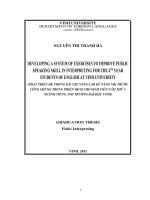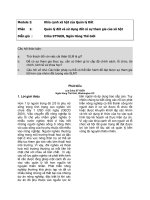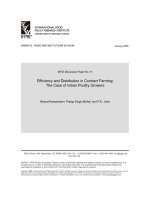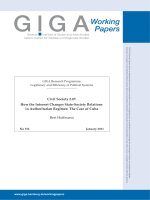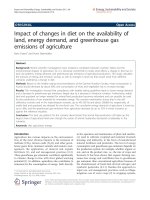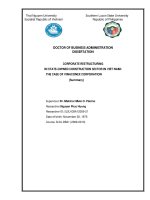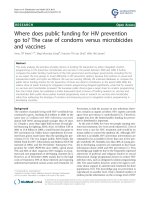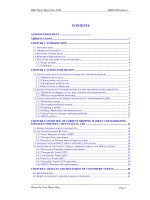Policy guide to improve water use efficiency in small-scale agriculture - The case of Burkina Faso, Morocco and Uganda
Bạn đang xem bản rút gọn của tài liệu. Xem và tải ngay bản đầy đủ của tài liệu tại đây (1.19 MB, 80 trang )
Policy guide to improve
water use efficiency in
small-scale agriculture
The case of Burkina Faso, Morocco and Uganda
Policy guide to improve
water use efficiency in
small-scale agriculture
The case of Burkina Faso, Morocco and Uganda
By
Maher Salman,
Senior Land and Water Officer, FAO
Eva Pek,
FAO Consultant
Nicola Lamaddalena,
Head of Land and Water Resources Management Department, CIHEAM IAMB
With contributions from:
Fethi Lebdi, FAO Consultant
Stefania Giusti, FAO Consultant
Abdelouahid Fouial, Research Fellow, CIHEAM IAMB
FOOD AND AGRICULTURE ORGANIZATION OF THE UNITED NATIONS
Rome, 2019
Required citation:
Salman, M., Pek, E. and Lamaddalena, N. 2019. Policy guide to improve water use efficiency in small-scale agriculture – The case of
Burkina Faso, Morocco and Uganda. Rome, FAO.
The designations employed and the presentation of material in this information product do not imply the expression of any opinion
whatsoever on the part of the Food and Agriculture Organization of the United Nations (FAO) concerning the legal or development status of
any country, territory, city or area or of its authorities, or concerning the delimitation of its frontiers or boundaries. The mention of specific
companies or products of manufacturers, whether or not these have been patented, does not imply that these have been endorsed or
recommended by FAO in preference to others of a similar nature that are not mentioned.
The views expressed in this information product are those of the author(s) and do not necessarily reflect the views or policies of FAO.
ISBN 978-92-5-131998-7
© FAO, 2019
Some rights reserved. This work is made available under the Creative Commons Attribution-NonCommercial-ShareAlike 3.0 IGO licence
(CC BY-NC-SA 3.0 IGO; />Under the terms of this licence, this work may be copied, redistributed and adapted for non-commercial purposes, provided that the work is
appropriately cited. In any use of this work, there should be no suggestion that FAO endorses any specific organization, products or
services. The use of the FAO logo is not permitted. If the work is adapted, then it must be licensed under the same or equivalent Creative
Commons licence. If a translation of this work is created, it must include the following disclaimer along with the required citation: “This
translation was not created by the Food and Agriculture Organization of the United Nations (FAO). FAO is not responsible for the content or
accuracy of this translation. The original [Language] edition shall be the authoritative edition.”
Disputes arising under the licence that cannot be settled amicably will be resolved by mediation and arbitration as described in Article 8 of
the licence except as otherwise provided herein. The applicable mediation rules will be the mediation rules of the World Intellectual Property
Organization and any arbitration will be conducted in accordance with the Arbitration Rules of
the United Nations Commission on International Trade Law (UNCITRAL).
Third-party materials. Users wishing to reuse material from this work that is attributed to a third party, such as tables, figures or images,
are responsible for determining whether permission is needed for that reuse and for obtaining permission from the copyright holder. The risk
of claims resulting from infringement of any third-party-owned component in the work rests solely with the user.
Sales, rights and licensing. FAO information products are available on the FAO website (www.fao.org/publications) and can be purchased
through Requests for commercial use should be submitted via: www.fao.org/contact-us/licence-request.
Queries regarding rights and licensing should be submitted to:
iii
Contents
Forewordv
Acknowledgementsvi
Acronymsvii
Introduction1
What are the Water Use Efficiency instruments (WUEis)?
3
Who should consider this guide?
3
How to consider WUEi?
4
Uncertainties in water use efficiency
5
WUEis come into practice
How WUEis evolved through the project
Policy guide for improving water use efficiency (WUE)
in Burkina Faso, Morocco and Uganda
7
8
11
WUE to meet SDGs, strategic objectives and the global water policy objectives
11
The overall picture in Africa
15
The African-led initiative towards hunger and poverty reduction:
the Comprehensive Africa Agriculture Development Programme
18
Moving forward: from the CAADP Process to the Malabo
Declaration and the CAADP Results Framework (2015-2025)
20
Women’s role in water management
21
Understanding the country focus: key features and
national policies affecting WUE
21
Burkina Faso
21
Morocco25
iv
Uganda29
Key achievements in water use efficiency for designing policy instruments
31
Burkina Faso: the case of pumped irrigation system
32
Morocco: improved production and drought preparedness
45
Uganda: the case of abundant water source
48
Conclusions63
References64
v
Foreword
Agriculture is still the engine of growth in the overall economic well-being in an increasingly
globalized world. Therefore, many countries aspire the economic development through agriculture,
thus making it the most important driver in water exploitation. While the demand is rapidly
growing, water resources are becoming limited that leads to overall imbalance between demand
and supply. A more efficient use of water in agriculture would certainly help. In response to this,
considerable number of policy initiatives came into force that promoted irrigation development to
keep up with the growing demand. However, many of them have not been brought to the ground
yet due to their little-explored effect on the economic, agronomic and environmental conditions.
The pathways of irrigation development – almost certainly essential for combating food security
and poverty – need new approaches to close the gap between the conceptual frameworks and
pragmatic approaches.
Creating policy instruments have received broad attention over the last decades to ensure the
sustainability of the resources. In many cases, water policies were introduced as integrated parts
of natural resource policy, energy policy or climate policy. The emerging concern of decreasing
water resources set the scope to improve governance in water sector to create more enabling
environment for policy and regulation. As the World Water Council, 2012 articulated “To improve
governance in the water sector, we need to balance social dimensions with economic demands and
environmental needs”.
Increasing potential output of water use is particularly important in countries where the majority of
the population is reliant on agriculture, and agriculture accounts a high share of water consumption.
Based on AQUASTAT statistics, agriculture shares the 69 per cent of the total water withdrawal, but
the ratio varies much between regions. Meanwhile, agricultural water withdrawal makes up only 21
per cent in Europe; it takes 82 per cent in Africa. As available water resources have direct impact on
the livelihood, the effective use of water is at the core of development and pro-poor strategies. One
of the striking constraints to achieve this goal is the fragmented size of lands, whereas small farms
create a high temporal- and spatial variability of water demand. Small-scale irrigation schemes
often present high degree of heterogeneity and disparity among the farmers and are less resourced
to increase efficiency. However, 80 per cent of the farms in sub-Saharan Africa are still cultivated by
smallholders, for whom enabling environment in increasingly needed. The objective of this guide
is to overcome these challenges and provide support to enhance water use efficiency in small-scale
schemes through policy recommendations (Bhattarai, Sakthivadivel, Hussain, 2002).
vi
Acknowledgements
The policy guide to improve water use efficiency in small scale agriculture is the joint effort of the
Land and Water Division of FAO (CBL) and of Mediterranean Agronomic Institute of Bari (CIHEAM
IAM).
The policy guide is based on the results of the FAO project “Strengthening Agricultural Water
Efficiency and Productivity at the African and Global Level” funded by the Swiss Agency for
Development and cooperation (SDC).
The authors of this policy guide are Maher Salman and Eva Pek from FAO; and Nicola Lamaddalena
from CIHEAM – IAM Bari.
The authors gratefully acknowledge the guidance received from Eduardo Mansur, Director of Land
and Water Division of FAO, and the contribution of Fethi Lebdi, Stefania Giusti and Abdelouahid
Fouial.
A special thanks to James Morgan for the design.
vii
Acronyms
AWM – Agricultural Water Management
AU – African Union
CAADP – Comprehensive Africa Agriculture Development Programme
CEN-SAD – Community of Sahel Saharan States
CFE – Financial and Material Contribution of Water
COMESA – Common Market for Eastern and Southern Africa
DSIP – Development Strategy and Investment Plan
ECOWAP – Politique Agricole Commune de la CEDEAO
ECOWAS – Economic Community of West African States
FAO – Food and Agriculture Organization
FWS – Flexible Water Service
GDP – Gross Domestic Product
IGAD – Intergovernmental Authority on Development
IWM – Integrated Water Management
MASSCOTE – Mapping System and Services for Canal. Operation Techniques
NAP – National Agriculture Policy
NDP – National Development Plan
NEPAD – New Partnership for Africa’s Development
O&M – Operation and Maintenance
viii
ONEE – National Organization of Electricity and Drinking Water (Morocco)
ORMVA – Regional Organization of Agricultural Development
PAGIRE – Action Plan for Integrated Water Resource Management
PNDD – National Sustainable Development Programme
PNGIRE - National Programme for Integrated Water Resource Management
PNIA – Programme National d’Investissement Agricole
PNSR – Programme National du Secteur Rural
RBO – River Basin Organisation
SCADD – Stratégie de croissance accélérée et de développement durable
SD – Sustainable Development
SDG – Sustainable Development Goal
SDR – Stratégie de Développement Rural
SNIEau – National Information System on Water
SO – Strategic Objectives
SP – Strategic Programmes
SSA – Sub-Saharan Africa
SSI – Small-scale irrigation
UGGDS – Uganda Green Growth Development Strategy
UN – United Nations
WUA – Water User Associations
WUE – Water Use Efficiency
WUEi – Water Use Efficiency instruments
1
Introduction
It is well demonstrated that agriculture has poverty-reducing impact, and well-designed
agricultural programmes have multiple effect on livelihoods, such as increasing household food
security, enhanced incomes, rural employment and resource efficiency. Irrigation is the core
to further increase the agricultural productivity and to gradually transform subsistence-driven
farming (Nechifor and Winning, 2018). Its pro-poor impact is particularly significant in the case of
smallholder irrigation schemes, where farmers have limited size of lands and resources to increase
their production. Appropriate policy response is required to support smallholders’ efforts that is
consistent with sustainability and economic objectives (Pingali, 2016; Moyo et al. 2017).
Drawing lessons from the results and impacts of Green Revolution have been brought to the fore
again as well as the strongly differing effect amongst regions that is under investigation (Bonnis,
Maestu., Gomez, 2011; Chronic Poverty Advisory Network, 2012). Identifying the underlying
issues of successful implementation or eventual failure is particularly important in the sense that
substantial investment will be required to cover about 172 million hectares of irrigation-equipped
area by 2050 (FAO, 2019). Irrigation development needs careful review for success in reducing
failures and maximizing benefits. The approach of designing irrigation policy has already witnessed
shifting to increase effectiveness. Participatory management, responsibility transfers to farmers,
equal distribution amongst users, environmentally sound technology and design and institutional
development are vivid proof of the efforts to improve irrigated agriculture (Gohar, Amer, Ward,
2015).
Underperformance of traditional irrigation systems results in many adverse effects. Considerable
water loss through conveyance, difficulties in controlling flow and distribution issues amongst users
are the most common problems faced by both farmers and managers. Farmers hold responsibilities
to improve the performance the irrigation systems, but sustaining the results and further progress
requires flanking and supportive policy (Hamdy, 2013).
This policy guide is drawn from the results of the FAO Project “Strengthening Agricultural Water
Efficiency and Productivity at the African and Global Level” funded by the Swiss Agency for
Development and cooperation (SDC). The long term vision of the project was that the in-country
findings and processes which are of common nature can be synthesized and scaled up to other
countries in a regional cooperation process and globally. This will eventually lead to the increase
of investment in Agricultural Water Management (AWM) in the targeted countries – and beyond –
that is socially equitable, profitable at the farm level, economically viable, environmentally neutral
or positive, and sustainable. The guide focuses on the specific component of enhancing water use
efficiency at small scale irrigation as one of the major outputs of the project. While creating and
implementing water use efficiency (WUE) measures at field level, existing policy frameworks were
2
Policy guide to improve water use efficiency in small-scale agriculture
mapped and analyzed, and recommendations were defined as scalable policy instruments with
the aim to demonstrate case-specific experiences to the collectively agreed goal of using water
resources efficiently.
Although the concept of adaptive water-management is not a newly introduced approach in
policy-making, it has not been used frequently in practice (Bormann et al, 1993; Pahl-Wostl et al,
2008; Pahl-Wostl, 2007). This guide is built on the systematic process of adaptive management
“learning to manage by managing to learn”. The guide is designed to lead the readers through
the policy-making process in various conditions of the pilot countries. It presents the key steps
overarching the country-specific implementation of development programme, design of combined
WUE Instruments (WUEi), and formulation of policy recommendations for small-scale irrigation (SSI)
by illustrating ad-hoc examples and case studies-based explanations.
Whilst the concern of the decision-makers is primarily the resource use efficiency, there are
numerous aspects of improving efficiency. Commonly, the potential objectives of water policies for
enhanced efficiency are (FAO, 2006):
• Improving efficiency of water use: 1) technical efficiency referring to the conveyance and
application efficiency of irrigation water; 2) financial efficiency describing the net return
of water use, and 3) economic efficiency considering the value for the society such as
externalities and alternative use of water.
• Equity amongst users: breaking through the evidence that locational advantage is difficult
to overcome, water policies foster the creation of equal provision between users. Where
there is equal access in water distribution, the impact of improved irrigation management on
productivity is more likely poverty-reducing.
• Sustainability of water-management systems: conceptualized environmental, socio-economic
and institutional sustainability in introduced policies.
The guide incorporates the implemented work, obtained data and processed information in three
countries: Burkina Faso, Morocco and Uganda.
Country-case and project
information
The light coloured boxes refer to the country-cases what
the guidelines build on. As case study, they are intended to
give information on the background that have been found
relevant in terms of WUEi.
Findings and highlights to
address by policies
The dark coloured boxes contain main findings and highlights,
which ought to be addressed by policies. The messages tend
to draw attention on the given facts and help to recognize the
major shortcomings of existing policies.
3
What are the Water Use
Efficiency instruments (WUEis)?
Defining the term “policy” is a complex task, which requires some flexibility for the permeability
between the sectors. In simple term, the policy is a formal process or plan for an action to achieve
a particular goal. The form of the policy varies on a wide range, for example, it can be economic or
regulatory. However, the guide does not consider policy as a linear process consisting of series of
steps (“policy cycle”), but rather an iterative process commuting between stakeholders.
The policy formulation goes back and forth between decision-makers and end-users. Breaking
down the process into particular means and tools to achieve the policy goals is called policy
instruments. Policy instruments are usually combined then to create pathway to reach these goals.
Five major types of policy instruments are differentiated: legislative and regulatory instruments,
economic and fiscal instruments, agreement-based or co-operative instruments, information and
communication instruments, and knowledge and innovation instruments. Instrument selection
must consider generic criteria and summarize the impact of the instrument (Delacámara, 2013). The
measured endorsement of instruments should be always inclusive, though, they also need to allow
for externalities (interference with other sectors, out-of-system effects, necessary trade-offs, etc.).
The key characteristics of the instruments is that they create a bridge between legislation/
framework and implementation. Therefore, WUEis were established on combined approaches
throughout the project cycle: (1) review and process of existing policies, institutions and
frameworks, and (2) experiences drawn from the field implementation. The combined approach
helps not only to collect possible instruments, but also to design them to address the specific issues
regarding to AWM. The complementary between existing policy frameworks and field experiences
ensures the adaptability of the instruments then. The formulation of WUEi involves sequential steps
presented on the flowchart of: policy review, evidence-based data collection, comparison between
theory and practice, design, and recommendations (Figure 1).
Who should consider this guide?
Evidence-based studies proved that irrigation can lower the poverty by average 20 per cent
compared to the adjacent rainfed areas, and that pro-poor management of water for farming
resulted in considerable gains in poverty alleviation (Lipton, 2002). Therefore, irrigation can be
an effective mean to address issues related to productivity, profitability and their direct effect
on food security and economic growth. Endorsement of more efficient use of water resources is,
thus, universally accepted. Yet, at least 40 per cent of irrigation water does not reach the fields in
4
Policy guide to improve water use efficiency in small-scale agriculture
Figure 1: The flowchart of designing WUEi through the project cycle
• Carrying-out desk research for existing policy, frameworks and governance scanning
• Assessing relevant resource efficiency policies
• Selecting the most fitting policies
Policy
review
• Identifying the gaps in the selected policies
Evidencebased data
Comparison
of theory and
practice
• Implementing water use efficiency
measures on the pilot schemes
Design
Water Use
Efficiency
Instruments
(WUEi)
• Drawing conclusions from the results
• Measuring the effect and impact of
the results
• Investigating the scalability of
the results
• Propose elements for up-scaling
• Finding complementarity between
existing policies and field experiences
• Eliminating the incompatibility
between existing policies and
field experiences
• Propose the design of the WUEis considering the type,
integration, flexibility, level and monitoring
Source: This study
surface irrigation schemes due to their poor maintenance, runoff, seepage, and other inefficiencies
of the infrastructure. Still 88 per cent of the irrigated areas in Sub-Saharan Africa is equipped with
surface irrigation systems due to its relatively low requirement of initial investment and operating
expenses. Since surface irrigation schemes have the lowest efficiency sharing the largest part of
irrigated areas, special attention should be paid to improve their performance. The current guide
sets a scope on surface irrigation schemes accordingly.
This guide is recommended particularly for decision-makers who attempt to overcome the limited
approach of end-of-pipe solutions, which can handle individual problems only temporary, and
those who recognize the importance of improving WUE to tackle the water-related issues.
How to consider WUEi?
Integrated approach for AWM combines the social, economic, environmental and political
circumstances, but this broad approach also embraces a large number of uncertainties. Each
irrigation scheme presents a combination of these conditions, which should be addressed by
different WUE measures. Before introducing the WUEi, it is important to recognize the different
types of uncertainties that act as key drivers of the instruments’ adaptability in local conditions.
What are the Water Use Efficiency instruments (WUEis)?
5
Uncertainties in water use efficiency
The most widely known uncertainty is the lack of information or the access to reliable data. Data
means any type of information influencing the water use such as hydrological, agronomic, climatic,
social or economic data. The data gap does not necessarily reflect on historical data, but real-time
data, which allow taking immediate action. The fact that majority of irrigation schemes are not
appraised regularly, and no baseline assessment supports the maintenance, rehabilitation and
modernization works, translates into declining efficiency.
“Good policy requires good data”. One of the main finding of the project while establishing the
baseline assessments is the lack of data at scheme level. None of the piloted irrigation schemes
invested in obtaining data in order to improve the management either at scheme or at farm level.
The project provided different means of data acquisition to ensure the measurability and the
sustainability of the results.
The same important but often less admitted uncertainty is the one of knowledge about the
system. Mismanagement of the system might derive from poor knowledge about the operated
infrastructure, required water service or environmental impact. However, the system users still
often work from insufficient information and they rely mostly on their own experiences. Farmers
hardly find access to training, information sharing or capacity-building events.
Each system has different levels and layers - both in infrastructural and management terms. While
the system-in-whole is often managed by institutionalized organizations such as Water User
Associations or governmental bodies, the lower levels are operated and maintained by social
institutions such as informal farmer groups. However, each level of an irrigation system is greatly
dependent on the other levels. Unlike in large-scale systems, the design of small-scale systems
is often influenced by farmers, thus, having asymmetries in system design. Enabling farmers to
understand contingency of cause-effect relationships in SSI contributes to the overall goal to create
reliable, flexible and equal access to water services.
Further uncertainties are the institutional and organizational uncertainties. In fragile systems,
institutional failures have even multiplier effects to exacerbate the situation. The complex system
of water governance consists of series of political, social, economic and administrative elements
that influence water management. It determines the water use, distribution, allocation, while
balances between the environmental and socio-economic constraints. However, the instruments
of governance are often not in place to manage this complex task, or often the sustainability of
existing policies are not supported by successive actions.
6
Policy guide to improve water use efficiency in small-scale agriculture
Wetland degradation is an emerging issue worldwide, and Uganda is not an exception. In total,
about 10 per cent of Uganda’s land is occupied by wetlands. Wetlands are severely exploited in
the country, and the situation is particularly difficult in the western part where 80 per cent of the
population is dependent on wetlands. After Canada, Uganda was the second country worldwide
who passed a wetland policy and allowed farmers to obtain licences to access wetlands.
Despite the vast number of laws and policies for environment and natural resource conservation,
the rapid depletion of catchment areas exceeds their renewal rate. Amongst the many factors of
degrading environment, the lack of incentives for more efficient water resource use, the limited
understanding of the importance of environment protection and the complete absence of data on
natural resources are the leading ones.
7
WUEis come into practice
Many instruments – directly or indirectly related to water – already exist in national and regional
frameworks, strategies, plans or policies. Nevertheless, most of them remains only theory due
to lack of effective mechanism bringing them to the ground. Tariffs, charges, agriculture-related
researches and subsidies are the most common instruments in Africa where access to water is a
critical factor of agricultural productivity. Through the project cycle, many cases proved that even if
the instruments are in force, their implementation has many shortcomings.
As the national diet in Burkina Faso has been significantly changing for 20 years, and rice is
replacing maize and millet as staple food, the food markets are under pressure to match the
increasing demand of rice to the less flexible supply side. Import tariffs are well-known instrument
to protect local producers from import markets. The question is that how fast farmers can react on
the increasingly rapid change in household consumption. Rice production has been supported by
a vast number of governmental programs in order to increase productivity thus meeting domestic
demand. The target of many irrigation development program was to reach such increased
productivity (Pingali, 2012). But, the overall yields of irrigated rice have remained low in the last
20 years thus making the further investment in irrigation infeasible. This low productivity together
with low profitability pose a risk in household food security in Burkina Faso (Barbier and Loncili,
2008).
As paddy rice is one of the most water consuming crops, the further improvement of irrigation
management is unavoidable to secure the situation of both farmers and consumers. This requires
harmonized policies to create enabling technical and economic environment.
WUEis are not only market instruments, which should affect through economic mechanisms. Welldesign interventions to increase understanding and knowledge, technology-support and voluntary
approaches such as participatory irrigation management (PIM) have the same importance though.
As well, many market-related situations, such as responsiveness to market changes, can be
influenced through information-based instruments that provide alternatives for decision-making.
8
Policy guide to improve water use efficiency in small-scale agriculture
Some examples from the project cycle:
Figure 2: Examples of different types of WUEis
Import
tariff
Burkina Faso
Economic
instruments
Burkina Faso
Water
charges
Subsidies
on water
infrastructure
Communitybased
management
initiative
Uganda
Agreement
based on
Cooperative
instruments
Uganda
Burkina Faso
Morocco
National
crop
programme
Uganda
Information and
Communication
instruments
Integrated
Water
Resource
Management
planning
Uganda
Burkina Faso
Burkina Faso
Morocco
Uganda
Transboundary
resource
management
Burkina Faso
Information
systems
for prices
Morocco
Source: This study
Many instruments are already introduced in many countries; considerable efforts were taken from
governments’ side to ensure efficient use of water. However, their adaptation in the practice is still
often in its infancy. In order to reinforce these instruments, field experiences must be aligned and
incorporated into their design.
How WUEis evolved through the project
The guide was constructed in a bottom-up approach integrating both field experience and existing
policies. Pilot schemes, which represent the common characteristics of typical small-scale schemes,
were selected and analyzed through comprehensive appraisals. The irrigation management
of the schemes was appraised through six successive steps, meanwhile, national policies were
investigated through extensive reviews and stakeholder consultations. The tried-and-tested
strategies are converted into WUEIs, and plugged into existing policy frameworks in order to fill
their gaps or increase their effectiveness.
9
WUEis come into practice
Figure 3: Process of mainstreaming WUEis into national and regional policies through
adaptive approach
Irrigation management at scheme level including:
Existing policies and frameworks including national plans,
legislations, strategies, regional frameworks etc.
1
Evaluate water
supply, water
demand,
accessibility
to water,
irrigation trends
2
3
Appraise the
water resources,
the infrastructure
and conveyance,
the water use
efficiency
Understand
the different
organizational
levels and
stakeholders
4
Assess the
overall water
service with
strong focus
on flexibility,
reliability and
equity
5
Define
management
strategies to address the
gaps in water
services while
considering
their impact on
the related
aspects
6
Implement the
recommended
strategies while
receiving feedbacks on the
implementation
Design scalable WUEi from the results
Develop policies aligned to the national and regional policy frameworks
Source: This study
1. Water supply, water demand, accessibility to water, irrigation trends
In first step, the project evaluated the applied water supply, water demand, farmers’ accessibility to
water and future projections on irrigation trends at national and scheme levels through MASSCOTE
approach.1 After investigating the national diet and cropping pattern, the most common crops
were selected to analyze farming practices. Water supply was estimated at scheme level, and
discharge monitoring protocol was set-up for each scheme to build-up discharge history. Overall
trends of irrigation water use were determined through establishing water balance in the schemes.
2. Water resources, the infrastructure and conveyance, the water use efficiency
Through the monitoring of water supply, the factors influencing the water resources, hydraulic
water balance, water use and distribution efficiency were defined. The step involved appraisal
of conveyance infrastructure from intake to final deliveries. The discharge monitoring revealed
hotspots of water losses and potentials of the better use of hydraulic structures. The WUE was
estimated through the conveyance system and the water balance at scheme and farm levels.
1
MASSCOTE – Mapping System and Services for Canal. Operation Techniques, FAO-developed methodology for irrigation
modernization
10
Policy guide to improve water use efficiency in small-scale agriculture
3. Organizational levels and stakeholders
Each scheme is governed by public bodies, water user associations (WUA) and the farmers (PIM). The
organizational levels were mapped and evaluated according to their responsibilities in irrigation
management. Disclosing the financial conditions and budgets of the WUAs helped understanding
the shortcomings in operation and maintenance (O&M), and the impact of management on the
profitability of farming.
4. Overall water service with strong focus on flexibility, reliability and equity
Overall water service was assessed through three major indicators: flexibility, reliability and
within-system equity. Flexibility of the water service investigated the responsiveness of scheme
management to changing water demand, varying conditions and farmers’ additional requirement.
Reliability of water services compared the effective operation of the system to farmers’ expectation.
Equity amongst farmers aimed at minimizing the inferiority of downstream farmers, and creating
in-system equity.
5. Management strategies addressing the gaps in water services
The project cycle included the development of guidelines on management rules to increase WUE.
The so-called Flexible Water Services (FWS) are scheme-specific guides to increase WUE while
outgrowing the irrigation requirements in both frequency/duration and amount terms. Meanwhile
management strategies were defined at scheme level, and WUE guidelines on farm level were
elaborated to support irrigation practitioners in enhancing irrigation practices.
6. Implementation of strategies while receiving feedbacks
The defined management strategies were trialed in the pilot schemes in order to prove their
feasibility in local conditions. While involving a wide range of stakeholders from irrigation
practitioners to decision-makers, dissemination activities to measure the willingness of adaptability
were included. The activities involved the surveying of farmers, discussion with the local authorities
and two regional workshops and a conference with decision-makers2
WUEis
The successive steps of establishing management practices, rules and
strategies lead to the final design of recommended instruments of WUE. The
instruments can be evaluated then and scaled-up to national and regional
level.
2
The thematic agenda and the discussion materials of the regional events can be found in the following links: August 2018,
Saskatoon, Canada, International Conference and 69th IEC Meeting of the ICID: />saskatoon2018/en/ August 2017, Bari, Italy, Emerging Practices from Agricultural Water Management in Africa and the Near East
– Thematic workshop: />
11
Policy guide for improving
water use efficiency (WUE)
in Burkina Faso, Morocco
and Uganda
As first step of the screening, the guide provides an insight into the most relevant international,
regional and national frameworks, strategies and policies in order to understand the possibilities
of mainstreaming WUE through WUEi and how it contributes to the development visions of the
countries. The chapter also underpins the link between international and the national policies.
Drawing from the national policies, the chapter looks for complementarity between the evidencebased recommendations and the existing frameworks.
WUE to meet SDGs, strategic objectives and the global water
policy objectives
The 2030 Agenda for Sustainable Development (SD) is adopted by the members of United Nations
in 2015. At the core of a consistent plan for sustainable development, 17 Sustainable Development
Goals (SDGs) are designed to embrace all aspects of SD while recognizing that ending poverty and
other deprivations can be achieved through improving health, education, reduced inequality and
spur economic growth. As access to water is a key issue of SD, it appears directly and indirectly in
many SDGs. Figure 5 gives an example on how water use and water use efficiency are mainstreamed
into the different specific targets.
Water related SDGs: Clean water and sanitation
The project focused on improving WUE in irrigation, which can reduce water loss, improve farmers’
income, and reduces the pressure on the ecosystem. This is in line with the Target 4 of the SDGs that
aims to increase, by 2030, substantially WUE across all sectors and ensure sustainable withdrawals
and supply of freshwater to address water scarcity and substantially reduce the number of
people suffering from water scarcity. Two indicators were developed to track the progress for this
target: 6.4.1 Change in water-use efficiency over time; and 6.4.2 Level of water stress: freshwater
withdrawal as a proportion of available freshwater resources. Decision makers can combine the
information from these indicators to understand how increasing water use affects the availability
of water resources and to define a tipping-point target for decoupling water use from economic
growth. Such information would enable countries to adequately follow-up on target 6.4. Improving
12
Policy guide to improve water use efficiency in small-scale agriculture
Figure 4: Water resource management mainstreamed into the specific SDGs
By 2020, sustainably manage and
protect marine and coastal ecosystem
to avoid significant adverse impacts
16
Ensure that all men and women have
equal rights to economic resources,
as well as control over land and other
natural resources
1
17
2
14
Percentage
12
47.5
20
5
Rural poverty headcount ratio
6
7
11
40
30
4
13
Integrate climate change measures
into national policies, strategies and
planning
50
By 2030, substantially reduce the
number of deaths and illnesses from
hazardous chemicals and air, water
and soil pollution and contamination
3
15
By 2030, achieve the sustainable
management and efficient use of
natural resources
10
9
8
14.4
Undertake reforms to give women
equal rights to economic resources
as well as control over land and
natural resources
Improve progressively global
resource efficiency to decouple
economic growth from
22.4degradation
environmental
Source: This study
10
0
Burkina Faso
Morocco
Uganda
The importance of the improvement of WUE increases with the level of water stress that countries face.
Improving the WUE in agriculture can increase the availability of water for other productive uses, and may
minimize impacts on ecosystems. This can be achieved by technical (physical and institutional) improvements,
appropriate policies and economic incentives.
Renewable water used for agriculture
Percentage
100
Water Stress
88
80
60
51
49
40
20
41
9
1
0
Burkina Faso
Morocco
Uganda
WUE in agriculture can also be related to the other targets of SDG 6, when considering the decline
in water quality of streams and groundwater due to uncontrolled drainage, capacity-building,
participatory water-management etc.
Water related SDGs: Contribution to environmental objectives
In the light of the SDGs 6 and 15, the main pathways for enhancing WUE in irrigated agriculture
are to increase the output per unit of water (engineering and agronomic management aspects),
reduce losses of water to drainage canals, water streams, and groundwater, reduce water
degradation (environmental aspects), and reallocate water to higher priority uses (societal
Policy guide for improving water use efficiency (WUE) in Burkina Faso, Morocco and Uganda
13
aspects). Unsustainable national water policy that does not consider the interrelations between
these three aspects will produce misleading objectives and eventually leads to environmental
degradation. Throughout the project, the interrelation between unsustainable water management
and environmental impacts were clearly defined. Soil degradation, drainage water pollution and
energy use due to over-pumping are some examples of the WUE and environmental impacts.
The project focused on improving WUE in irrigation, which can significantly decrease the pressure
on the environment by reducing water pollution and reducing water abstraction from streams
and groundwater. This is in line especially with the Target 1 of the SDG 15 that aims to conserve
freshwater ecosystems.
Water related SDGs: Contribution to agriculture as poverty reduction measure
In African countries, a large percentage of the population relies on agriculture, and many of them
live in extreme poverty. There is a positive, though complex link between good water-management
that increase WUE in irrigation and other farm use, poverty alleviation and food security. Many of
the rural poor work directly in agriculture, as smallholders or farm laborers. Their income can be
significantly boosted by appropriate WUE measures that contribute to reducing poverty, such as
ensuring fair access to water and land, as well as good governance. Relevant reforms of agricultural
policy and practices can strengthen these measures. The availability of water opens various
opportunities to individuals and communities to boost food production, to satisfy their own needs
and to generate income for improving their livelihood. Good irrigation practices have a positive
effect on crop production, meaning the difference between extreme poverty and the satisfaction
of the household’s basic needs.
Increasing WUE in agriculture can improve farmers’ income as well as the livelihood of rural
communities. This is in line with the SDG 1 that refers to the ending of poverty in all its forms
everywhere and the target 1.1 stating that by 2030, extreme poverty must be eradicated for all
people everywhere.
Water related SDGs: Contribution to socio-economic objectives as hunger
eradication measure
Globally, one of nine people in the world today (815 million) are undernourished. The majority of
these people live in developing countries, where 12.9 per cent of the population is undernourished.
Poor nutrition causes nearly half (45 per cent) of deaths in children under five – 3.1 million children
each year. One in four of the world’s children suffers stunted growth. In developing countries, the
proportion can rise to one in three. 66 million primary school-age children attend classes hungry
across the developing world, with 23 million in Africa alone. On the other hand, agriculture is
the single largest employer in the world, providing livelihoods for 40 per cent of today’s global
population. It is the largest source of income and jobs for poor rural households. 500 million small
farms worldwide, most still rainfed, provide up to 80 per cent of food consumed in a large part of
the developing world. Improving WUE in agriculture improves food production and farmers income.
14
Policy guide to improve water use efficiency in small-scale agriculture
Concentrating the investing in smallholder women and men is an important way to increase food
security and nutrition for the poorest, as well as food production for the local and national levels.
The pro-poor effect of irrigation has a great importance in SSI which provides income for rural labour, increases
household food security and creates workplace. As Lipton et al. (2002) together with FAO reported “smallscale, low-cost and labour-intensive irrigation techniques that can be accessed by small, capital and/or creditconstrained farms are more likely to be of benefit to the poor than large scale, capital-intensive technologies”.
As the indicator of rural poverty headcount ratio at national poverty lines shows, the high degree of rural
poverty is present in each country.
Irrigation development can be considered as potential strategy for the governments and their agencies to
combat poverty.
Rural poverty headcount ratio
Percentage
50
47.5
40
30
22.4
20
14.4
10
0
Burkina Faso
Morocco
Uganda
Undernourishment rate in Burkina Faso and Uganda is above both the world and Africa average. Even though
Uganda has enough water compared to Burkina Faso and Morocco, the percentage of undernourishment in
three-year-average kept rising reaching over 40 per cent.
Renewable water used for agriculture
Percentage
Percentage
100
45
Water Stress
88
40
80
35
60
51
49
30
41
40
25
20
9
20
1
0
15
10
Burkina Faso
Morocco
Uganda
5
0
World
Africa
Burkina Faso
Morocco
Uganda
Policy guide for improving water use efficiency (WUE) in Burkina Faso, Morocco and Uganda
15
The overall picture in Africa
FAO predicts that the world population is expected to grow by over a third between 2009 and
2050, and half of the growth will occur in Africa. This entails the need to increase the global food
production by 70 per cent in this period. Also, agriculture sector must be prepared to absorb the
increasingly growing rural labour as in Africa alone, annual 11 million young people will enter the
labour market in the next decade. On the other side, irrigation potential is higher than the recently
exploited. In Sub-Saharan Africa (SSA), only 4 per cent of the arable land is irrigated, and 2 million
of the 7 million hectares of the equipped land are not under production. The large ratio of rural
population triggers the increase of productivity of the agriculture through public programmes
thus creating many public schemes assigned to smallholders (FAO, 2011; FAO, 2016; FAO, 2017;
OECD-FAO, 2018).
Many schemes suffer from shortcomings, which undermine their profitability. They are often
fragmented into simply too small plots to provide economic threshold for the minimum
subsistence. In addition, these schemes are often designed as part of the national food security
measures and farmers are suggested to select staple-crops, which are less profitable than other
cash crops. The lack of profitability is then translated into shortfalls of operation and maintenance
works (O&M), under-resourced reinvestment and other management failures (World Bank,
2008). Farmers, who consider themselves as transitioning from subsistence-based production to
commercial farmers, turn the irrigation schemes into multi-cropping systems with a large variety
of staple and cash crops (Bjornlund and Pittock, 2017). The investment in flexible irrigation systems
allows the intensification and diversification of agricultural production with multiple high value
crops per year to lead farmers out of the low-yielding rain fed agriculture (Grace, 1997).
SSI are in the scope of the project, none of the pilot scheme exceeds the 1 000 hectares, and the
average land size per farmers varies between 1 and 3.5 hectare. While investigating the pathways
for development, the interventions must consider the economic feasibility. As farmers are
resourced low and their capacity is limited to deploy new practices and technologies, therefore,
the WUEis design must adopt gradual approach.
Considerable number of policy initiatives came to force to promote irrigation development in
SSA and to keep up with growing population. In 2002, African Ministers’ Council on Water was
established to provide institutional framework for water-management, and in the same time,
Maputo Declaration was established to adopt the overall objectives of Comprehensive African
Agriculture Development Programme. From the institutional cooperation, regional policies were
elaborated to declare the shared vision of SSA countries on joint water-management. Such
instruments were the regional water strategy adopted in 2006 and regional water policy in 2005
to support the common planning and construction of water storages (Mwamakamba, 2017).
According to the Investment Sourcebook of World Bank (2005), the challenges facing AWM
